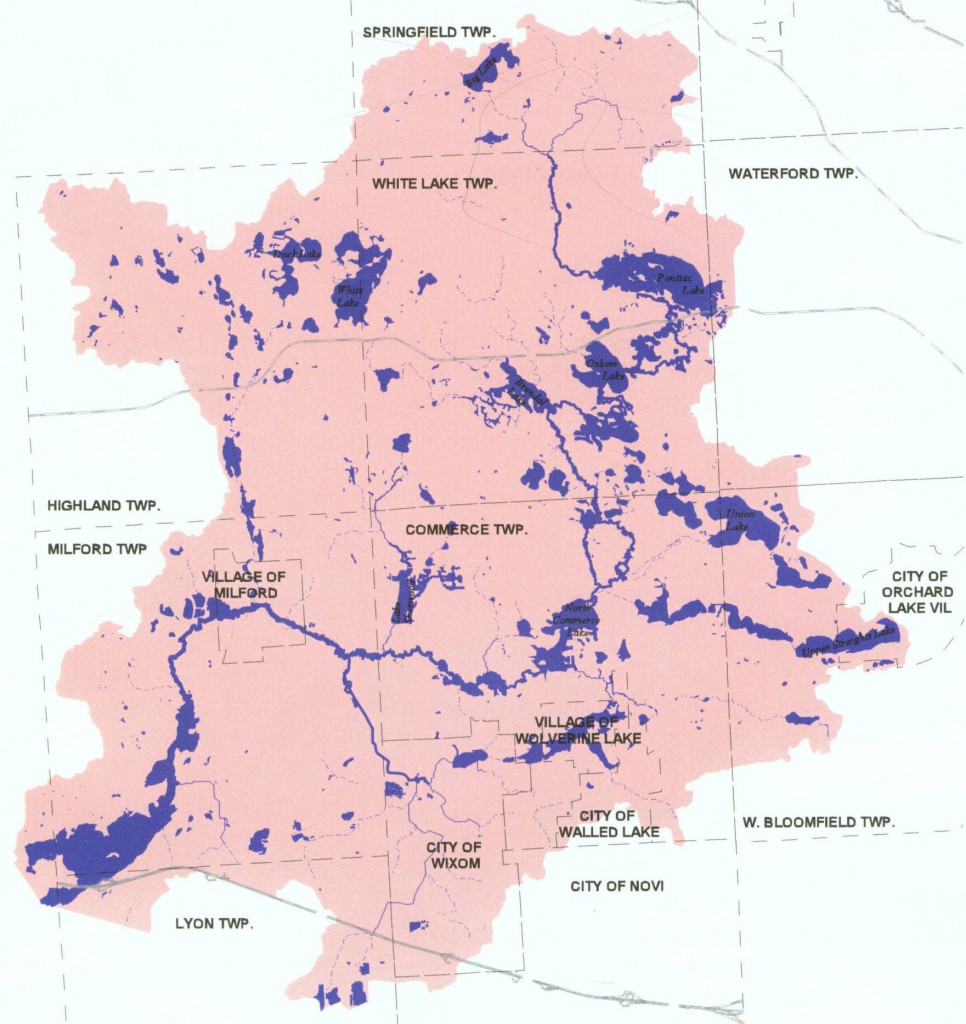The Upper Huron

The portion of the Huron River Watershed known as the Upper Huron is a 107 square mile area that extends from the headwaters of the Huron River downstream to the Kent Lake impoundment in Kensington Metropark. The Upper Huron contains nearly 700 individual lakes comprising approximately 9,000 acres, Pettibone and Norton Creeksheds, and innumerable wetlands providing water quality and aesthetic value. The subwatershed lies within Oakland County and comprises all or portions of the Townships of Commerce, Highland, Lyon, Milford, Springfield, Waterford, West Bloomfield and White Lake, the Villages of Milford, Orchard Lake and Wolverine Lake, and the Cities of Novi, Walled Lake and Wixom.
The Upper Huron is a mixture of urbanized areas and rural/agricultural lands, many of which are experiencing some of the state’s most intense development pressures from a growing economy and urban sprawl. The natural ecosystem and the water used for drinking, swimming, fishing, and boating is threatened by the cumulative impacts of urbanization via stormwater runoff, poorly maintained septic systems, increased sewage discharge, alterations in water flow, and development in wetlands and floodplain woodlands.
For additional information about the Upper Huron’s geography and water quality, visit HRWC’s Infostream.
Work in the Upper Huron
Along with communities from the area, HRWC established the Upper Huron/Kent Lake Subwatershed Advisory Group (SWAG) in 2000 to develop the initial Kent Lake Subwatershed Management Plan prepared under section 319 of the Clean Water Act to meet the Total Maximum Daily Load (TMDL) for phosphorus. Public participation was a major component for this plan, including the use of a series of press releases, two public meetings and six news articles to help garner participation and input into the development and implementation of the plan.
During development of the subsequent Upper Huron/Kent Lake Subwatershed Management Plan finalized in 2006 and required as part of the Phase II Watershed-based Storm Water Permit program, the SWAG held two public forums and received feedback from the general public through the use of surveys.
In order to meet these phosphorus TMDLs and improve overall water quality, HRWC and SWAG partners have employed a broad range of tools. Managerial best management practices (BMPs) include institutional, educational, or regulatory measures of pollution prevention. Managerial BMPs focus on modifying behaviors and practices through a wide variety of activities such as adopting new policies and ordinances regarding land use planning, providing watershed public information and education to residents, and conducting monitoring.
While the SWAG no longer meets regularly, HRWC continues to work on projects to improve water quality in the Upper Huron. Currently, HRWC is also overseeing the development of stormwater demonstration projects in Wixom to replace conventional and poorly designed stormwater detention basins with innovative designs to reduce loads of phosphorus and other pollutants to the Huron River and Norton Creek.

Kent Lake Watershed
The Kent Lake subwatershed covers 156 square miles in southwestern Oakland County, extending from the headwaters of the Huron River downstream to the Kent Lake impoundment on the Huron River in Kensington MetroPark.
HRWC facilitated the development of a watershed management plan for this Oakland County watershed from 2000 to 2002, and worked with partners to implement priority activities such as two stormwater best management practice retrofits.
Following a two-year planning process that involved local communities, county agencies, key business interests, citizens groups, and other stakeholders, the Kent Lake Subwatershed Management Plan was approved by MDEQ in August 2002. The Plan sets forth a comprehensive, long-term effort to restore and protect the water quality of the Kent Lake subwatershed with the goal of attaining the Kent Lake TMDL for non-point phosphorus pollution. Approval of the Plan by MDEQ and EPA makes the Kent Lake communities eligible to compete for implementation funds to address problems such as high nutrient loading, stream bank stabilization, soil erosion, and other activities identified in the Plan.
The Plan includes the following list of prioritized subwatershed concerns as developed by the working group:
- Excessive impervious surfaces
- Wetland loss
- Impaired septic systems
- Need for enhanced watershed-friendly planning
- Illicit connections
Sources and causes associated with these priority concerns are presented in the Plan, along with a list of twelve goals and objectives. An Action Matrix identifies specific potential actions that are recommended to achieve the goals and objectives. The actions range from managerial practices (e.g., new and revised ordinances) to structural practices (constructed wetlands and wet detention basins) to vegetative practices (e.g., vegetated riparian buffers) to improving monitoring programs and data collection. The combination of actions taken will be determined by each community based on cost, acceptability, and sustainability.
HRWC has completed two EGLE-funded (formerlly MDEQ) grants to implement some of the Plan’s recommendations. These grants have served to improve public education on watershed issues, identify opportunities for stormwater BMP retrofits (which have subsequently led to two other grants now in progress for constructing the retrofits), and work with local governments on improving local codes and ordinances.
How can you help or get involved with implementing the Kent Lake Subwatershed Management Plan?
- Let us know if you know of any areas in particular need of streambank restoration, stormwater controls (such as detention ponds, infiltration basins, ect.) or if you area a property owner who would like to restore wetlands on your land. We can help you create a site plan and search for funding.
- If you are interested in getting involved in a citizens group, we may be able to connect you with other interested people.
Save
More Information
For additional information about HRWC’s work in Upper Huron, contact Ric Lawson.



